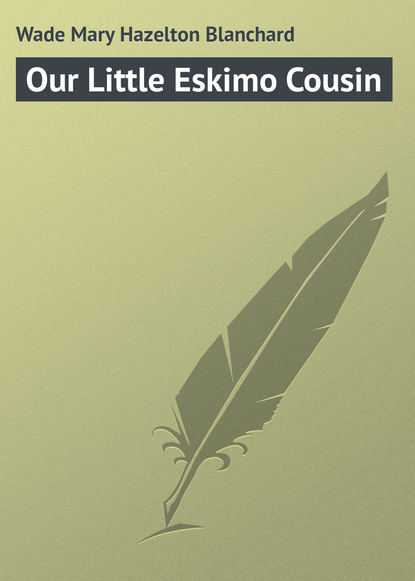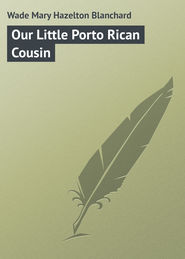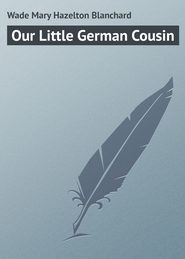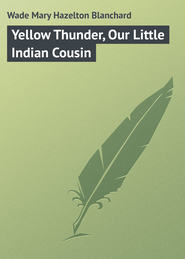По всем вопросам обращайтесь на: info@litportal.ru
(©) 2003-2024.
✖
Our Little Eskimo Cousin
Настройки чтения
Размер шрифта
Высота строк
Поля
It is fun to watch Etu on feeding day. He gathers the dogs around him in a wide circle, and tosses first to one, then to another, his strip of sealskin. If a dog moves from his place or jumps out of turn to receive his food, he is only rewarded by a lash of the whip, instead of the longed-for meat. So by long experience they have learned to wait patiently.
These Eskimo dogs must have wonderful stomachs to digest the tough food on which they live. It is simply impossible to chew the strips of skin, so they are swallowed whole. Sometimes a young dog chokes over his hard work, and coughs up his precious bit, only to have it snatched away from him by one of his neighbours.
We feel like pitying these dogs of the cold lands. They are deeply devoted to their masters, yet a word of kindness is rarely spoken to them. Their work is hard, and their food is scant. In winter they must draw the sledges, and in summer, as their masters travel from place to place, they are laden with heavy packs which they carry cheerfully.
This reminds me that when Etu played "horse" in his early days, it wasn't horse, after all; it was dog, instead, for the Eskimo dog is the only horse of the far north.
When Etu was old enough to drive a team of a dozen dogs, he had reached his tenth birthday. His father said to him then:
"Now, Etu, you are old enough to make your own sledge. You have often helped me, but now you are able to do the work alone."
Our little cousin set manfully to work at once. It was so nice to think of having a sledge for his very own, and one that he had made himself, too. It was not a very hard task, once he had gathered his materials together. The jawbones of a whale were used for the framework and runners. Sealskin was fitted over this framework, and a little seat made from which Etu's legs hung over in front when he was driving.
"But will the bone runners travel swiftly enough over the snow?" some one asks.
"Not unless they are properly iced," Etu would answer.
Every time the boy starts out on a journey, he must prepare the runners afresh by squirting water upon them from his mouth. A coating of smooth ice is formed almost instantly, which will last for a short distance. Then it must be renewed.
Soon after Etu's sledge was completed, he was sent by his father to look for seal-holes along the coast. It was a bright, clear day, and, although it was fifty degrees below zero, the boy enjoyed his ride; he had no thought of cold, as there was only a slight wind blowing.
He journeyed on and on, his bright eyes watching for signs of seals beneath the snow-covered ice. He did not realise how far he was from home. He was many miles away, when a strong wind suddenly arose. How it cut his cheeks and bit his nose! He knew he must turn back at once or he might be overcome.
Brave boy as he was, there would keep entering his mind the thought of a neighbour who was frozen while travelling in just such weather. When his sledge arrived at his own doorway, there sat the man in his seat, straight and stiff; but the reins were tightly held in dead hands. The dogs had kept on their way unharmed, while the driver gradually lost all knowledge of them, and of this world.
Etu put his gloved hand to his nose again and again, to make sure it was all right; it was such an easy thing for it to freeze without his knowledge. And now his hands began to grow numb, and then his feet, although he often sprang from his sledge to run with the dogs and jump in the snow.
Ah, that icy wind! Would it never stop? The boy's eyes became blinded, and at last he thought:
"It is of no use. I don't care very much, anyway. I begin to feel so queer and stupid. What does it mean?"
That was the last he knew till he awoke in his own home to find his mother bending over him; she was rubbing him with balls of snow, and looking very, very anxious. How the blood tingled through his body, as it began to move freely once more! But he was safe now, and could no longer feel the terrible wind blowing against him.
It was a narrow escape for Etu. It was well for him that he was within a mile of the village when he lost the power to think. The dogs kept on their way, and brought him quickly to his own home.
CHAPTER V.
KAYAK AND HARPOON
When Etu was only nine years old he began to go out upon the ocean, fishing and shooting with his father. Of course he was allowed to go on calm days only. Years of practice would be needed before he could be trusted to manage his boat in winter storms, or risk his life in seal hunting. When he was eleven years old, however, he had learned to paddle very well, and, besides, he had grown to be such a big boy that his father said:
"You must have a new kayak, Etu; your mother will help you make it. You have outgrown the other, and it is not safe."
It was one of Etu's duties to watch for all the driftwood floating in toward shore. Every piece is more precious to these people of the north than we can imagine. They have no money, but if they could express the value of the bits of driftwood in dollars and cents, we would be amazed. Some of us, I fear, would feel like carrying a shipload of lumber to Etu's people and making a fortune very easily.
When our little Eskimo wished to begin the making of his boat, he went first to the family treasure house. Of course you can guess what was stored there. Not diamonds and pearls, nor gold and silver; but simply – driftwood.
Etu chose with much care the pieces from which to make a stout framework for his boat. It was important that he should take light wood that had not lost its strength by drifting about in the water too long. He cut the strips with a bone knife and bound them into shape with strong cords of seal sinew. The ends of the boat were sharply pointed.
His mother's work began now. She took the skins of seals which her husband had just killed and scraped away all the scraps of blubber and flesh left on the hides. Then, rolling them tightly together, she left them for some days. When they were again unrolled, it was quite easy to scrape off the hairs with a mussel shell. After this, the skins were well washed in sea water.
A very important step must be taken next. The skins must be stretched. Etu's first boat must be a fine one and there must be no wrinkles in the covering. The safest way was to stretch them over the framework of the boat itself. Then they would be sure to fit well. An Eskimo woman feels very much ashamed if any part of the boat's covering is loose or wrinkled. People will think she is a poor worker, and that would be a sad disgrace.
How did Etu's mother manage to make the boat water-tight? It was done through her careful sewing. She worked with her coarse bone needle, and the sinews of seal and deer were the only thread; yet when the kayak was finished, not a single drop of water could enter. It was a clever piece of work.
Where was Etu to sit in this wonderful boat? The deck was entirely covered excepting the small hole in the centre. The boy had measured this hole with great care when he made the framework of the kayak. It was just large enough for him to squeeze through. His feet and legs must be underneath the deck, and his thighs should fill up the hole exactly. Now you understand why the boy's father spoke of his outgrowing the old boat.
Do you also see why there was no larger hole? Think for a moment of the waters through which he must ride. Our rough seas would seem calm to Etu. If the deck were not covered, the dashing waves would swamp his boat almost instantly. His people had found this out for themselves; so they cleverly planned a boat different from that of any other in the world.
Etu made a stout paddle with two blades. It is a pleasure for his mother and her friends to watch him use it. He is very skilful, and now, at twelve years of age, he can make the kayak skim over the water like the wind. How straight he always sits! He balances the boat exactly and first bends the right blade into the water, then the left, without seeming to work hard, either. And in some wonderful way, one can hardly understand how, he speeds onward. No wonder it is such a pleasure to watch him.
Etu is very proud of his paddle; not because he made it, but because of the time his mother spent in decorating it. It is inlaid with bits of stone and ivory set in a pretty pattern. Surely, his mother is a fine worker. She has just made him a present of a new pair of gloves. They are to be worn while he is out in his boat, and reach above his elbows. They will protect his arms and keep them dry, even if the waves sweep clear over him. But they are not like common gloves, for they are embroidered in a fine pattern. She cut out bits of hide and dyed them different colours. Then she sewed them together in a neat design on the arm pieces of the gloves. Shouldn't you call that embroidery?
While Etu's boat was being made, his mother had a party. Perhaps it would be better to call it a "sewing-bee." Etu was sent around to the different women in the village. He told them his mother was ready to sew the covering on his boat. Would they like to help her?
Now there is nothing Eskimo women like better than to come together for a friendly chat. So the invitation was accepted, and one morning, bright and early, a party of women could be seen gathered around the sealskins. Their fingers worked swiftly, but I fear their tongues moved still faster. There was a great deal of laughter, for they seemed to have many funny stories to tell. And I don't believe there was a bit of unkind gossip; at least, their faces didn't show it.
It was amusing to see how much their teeth were used. They were like another hand to these Eskimo women, for, as they sewed, they held the piece of skin in its place with their teeth. When the covering must be stretched over this hard place or that edge, it was the teeth again that gave the needed help. Etu knows one old woman whose teeth are worn almost down to the gums. She must have worked very hard all the years of her life. She must have sewed on many boat-coverings and made many suits of clothes before this could have been done.
When Etu's kayak was finished, his mother invited the workers up to the house, where they were treated to a dish of seal-blood soup and a pipe of tobacco. It was a grand surprise. In the first place, the heated blood of the seal is always a dainty; and then, they seldom had the privilege of smoking tobacco. It was a great rarity, for it could only be obtained through trade with the white people.
When night came, all were in great good humour as they left for their own homes. But, as they stepped outdoors, what a beautiful sight met their eyes! The northern lights were shooting across the heavens in glorious colours. Have you never noticed on cold winter nights lines of light shooting upward into the sky? It is always in the north that we see them, and we wonder and exclaim as we look.
Your mother tells you, "It is the Aurora Borealis." It is not fully known what causes the strange light. It is thought, however, to be electricity.
In Etu's land the aurora is far more wonderful and beautiful than with us. The visitors were used to such sights, yet they called to the boy and his mother to come outdoors and look.
"The lights are brighter than I ever saw them in my life," exclaimed one of the women. At first it seemed as though there were a great cloud of light just above the horizon, but it suddenly changed till the heavens appeared to be alive. The very air around the people quivered, as long, bright lines shot upward across the sky. They changed so quickly, it seemed as though a mighty power was directing them about, now here, now there. It made one dizzy to watch them. Now there would be streamers of green and red and blue darting from the sky-line way to the very zenith. There they would meet in a purplish crown of glory.
Again the sky would change in its appearance, and a red light would spread over all. It was so bright that the snow in every direction was tinted a rosy colour.
"What makes it, mother?" whispered Etu. "Is it the work of good spirits, or are evil ones trying to show us their power?"
"I do not know, my child," was the answer. "We are not wise, and cannot understand these things. Come, let us go back into the house. The sight makes me fearful."
Etu had many finishing touches to put on his boat after it was covered. A wooden hoop must be fitted around the hole in which he was to sit. Several thongs of seal hide must be fastened on the deck, under which his spear and harpoon should rest while he paddled. Still other straps were bound to the sides of the deck, for, unless the birds or seals could be fastened to the boat in some way after they had been killed, how could they be towed home?
Then Etu began to work on his harpoon. His father had to help him now, for it needed skill and care to fit it exactly to the throwing-stick. The Eskimos long ago found that the bow and arrow were not useful in their narrow, dangerous boats. Only a one-handed weapon can be used in such a place, so they invented the harpoon and the bird dart.
The harpoon is a long piece of wood pointed with bone or iron. It is fastened into a handle of wood called a throwing-stick. A cord of seal hide is attached to it at the other end. You should see our stout little Etu riding the waves in his kayak, and balancing the throwing-stick on his shoulder to send the harpoon flying straight to the mark. But suppose the harpoon lodges fast in the seal's body; if the hunter still holds the other end of the cord attached to it, the creature in his fury may make such plunges as to drag the boat and all down under the water and destroy them. Something else must be invented. This was the buoy or float. So it was that Etu had to make a buoy to complete his hunting outfit.
He took the skin of a young seal, from which his mother had scraped off all the hairs, and tied up the holes made by the head and legs. Through a small tube fastened in the skin he could blow up his queerly shaped buoy to its fullest size.
Now the float was completed. Do you understand what help it would give? If the float is attached to the other end of the line when the harpoon is thrown, the hunter can let everything go. He does not need to have any part fastened to the boat. For the float cannot sink, and will show him where to follow the game, and where to throw next; yet he is himself in no danger of being pulled after the animal.
Even now Etu would not be safe to go hunting in rough waters. He must have a special coat prepared. This, again, was his mother's work. The skin of the seal was used after all the hair was removed. The jacket was made to fit closely over his other garments. It had a hood to be drawn tightly over his head, long sleeves, and drawing-strings around the neck and lower edge.
When Etu gets into his boat he must fit his jacket around the hoop of the sitting-hole, and draw the cord tightly. And now he seems a part of the boat itself. No water can enter, and although the waves may dash completely over him he will keep dry, and the boat will not sink.











